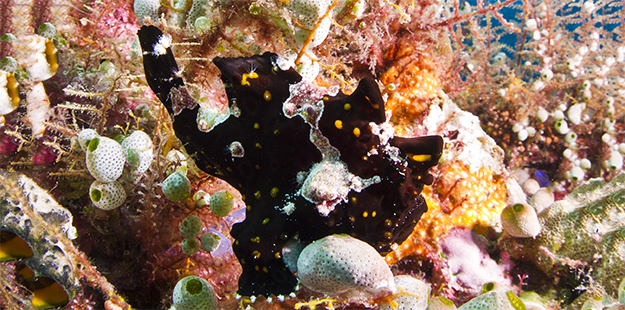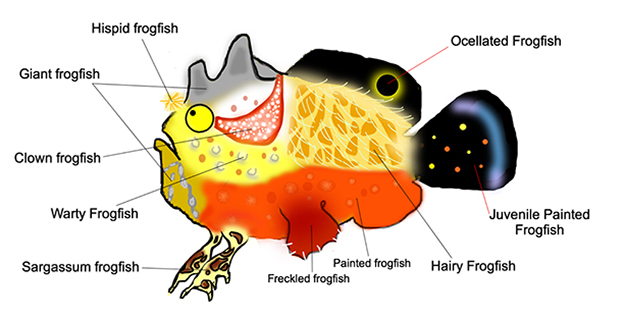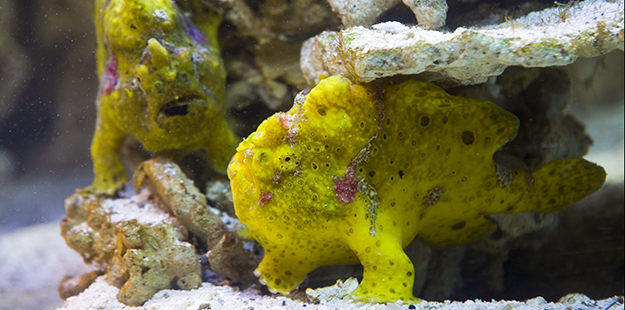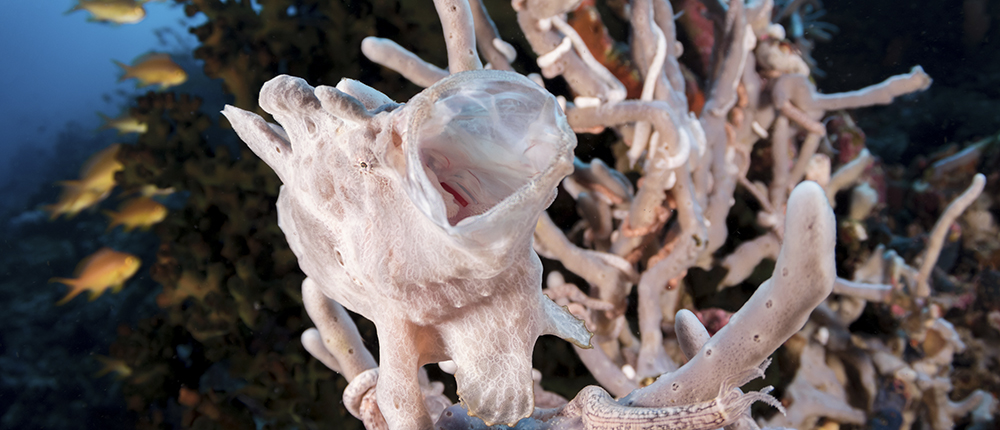Wakatobi’s Burping Sponges
Finding frogfish on the reefs of Wakatobi Resort
The reefs surrounding Wakatobi Resort teem with literally thousands of species of fish and invertebrates. So why, given this abundance of unique and colorful marine life, do divers devote bottom time to seeking out a sedentary and—let’s face it—ugly little fish that is the underwater realm’s equivalent of a couch potato. Or, as some divemasters have labeled the frogfish, “a sponge that burps.”
Hiding in plain sight
Frogfishes are masters of concealment, able to change their coloration and even their physical appearance to match their surroundings. Many a diver have unknowingly swam right past a frogfish, assuming that little yellow or purple lump tucked into a ledge was some type of sponge.

Can you see the frogfish? It’s not uncommon to swim right past a frogfish as it hides tucked into a coral ledge. Photo by Warren Baverstock
It takes a sharp eye to spot one amid the colors and patterns of Wakatobi’s reef, but because they tend to stay in one place, it’s often possible to return to the same spot and find the same animal. Wakatobi Resort’s dive guides are experts at spotting frogfish, and are happy to direct guests to known individuals, or help seek out new finds.
If a frogfish were to change its hiding spot, it could alter its coloration to match the new surroundings. But this doesn’t happen often, as these lurkers don’t get around much. When they do move, they are as likely to walk as to swim. Frogfish often use their pectoral and pelvic fins to push themselves along the sea bottom with a loping, wobbling gait, to even appearing to stumble like someone who is highly inebriated. They can swim reasonably well when the need arises, but because they lack a swim bladder, they can’t achieve neutral buoyancy, and tend to move in a series of arching bursts that lands them back on the sea floor. A frogfish can also pump water out their gill openings to create a sort of jet propulsion effect.

Identifying the more than 15 species of frogfish native to Wakatobi’s waters can be a fun challenge.
There are more than 15 species of frogfish native to the Wakatobi region, but identification can be a challenge, as juveniles and adults can look quite different, and individual fish of the of the same species may not share the same colors or shapes. Making a positive ID might be tough, but dedicated frogfish watchers eventually learn to recognize subtle differences in fin shape and other variables.
The largest member of the frogfish family you are likely to discover on Wakatobi reefs is the Commerson’s frogfish, also known as the giant frogfish. These can grow to lengths of 45 cm, and are usually found on reefs and walls at sites all around Wakatobi Resort. Two prime places to find them are Table Coral City and Treasure Chest. Other species commonly seen are the warty frogfish and the painted frogfish. Both of these species come in a variety of colors from white to cream, pink, yellow, red, brown and black, with skin textures that range from velvety-smooth to algae-covered warts, or spots that match those of their habitat. These two varieties can be hard to tell apart, but a specimen larger that 15 cm is probably a painted frogfish.

Pygmy frogfish reach a max 1.25 cm and are typically found flitting about more actively among the coral or sandy bottom. Photo by Cor Bosman
Harder to find are the pygmy frogfish, which are more likely to be found in coral rubble or the grass beds in the shallows of the House Reef. These little guys reach a maximum size of 1.25 cm, and may be more active, as they are fearful of being consumed. Of course, when you find a small frogfish, it might not be a pygmy, but merely a juvenile member of another species.
The fish that fishes
Slow, reclusive and lacking in both offensive and defensive weaponry – not to mention being far from streamlined – the frogfish wouldn’t seem to have the tools needed to become a lethal predator. Yet despite some seeming shortcomings in the attack department, these enigmatic little creatures have developed a unique strategy to capture prey: they remain stationary and camouflaged, and go fishing.
This video shows some hungry frogfish on Wakatobi’s reefs, one in particular right under the resort’s jetty.
The frogfish’s fishing rod is actually a modified dorsal fin with a fleshy appendage at its end, which serves as bait. To attract a meal, it flicks the bait up and down, just like a fisherman working a lure. If a potential target did manage to dart in and steal the bait, the frogfish is able to grow a new appendage to replace what was bitten off.
The frogfish diet includes crustaceans, fish and even other frogfish on occasion. When a potential meal gets within six to seven body lengths, the frogfish begins its fishing routine, moving its lure to mimic a swimming or drifting morsel. If the potential prey becomes interested, the frogfish may make a slow, stealthy advance, or it may just lie in wait while working the lure. Once the victim is lured within striking range, the frogfish attacks. But this is no lighting-fast pounce – though it does take place in less than 100th of a second. Rather than move in on the prey, the frogfish literally sucks dinner into its mouth by opening its jaw with near-instantaneous speed. This rapid expansion enlarges the mouth to more than ten times its resting size, creating a powerful suction that pulls the meal in.
Super-sizing the bite also allows the frogfish to gobble up catches nearly as large as themselves, and its stomach can also expand to accommodate big meals. But because have tiny teeth, a frogfish can’t nibble on its catch one bit at a time, and must instead swallow it whole. This can create some comic moments when a hungry frogfish tries for too large of a meal.
Frogfish’ fish-eat-fish relationships
Frogfish are loners by nature, don’t move around much, and may be so well camouflaged they can’t be spotted even by other frogfish – all of which adds complications to the dating scene. The answer is chemistry. Courtship begins when a female releases a powerful pheromone to attract her suitors. Should a male come calling, he may proceed cautiously as his would-be mate is likely to be the dominant partner in the equation, as females typically grow larger than males. And should she not be fully ready to mate, the result for the smaller suitor may be getting a vicious nip – or becoming a meal. And the fun doesn’t end there. If more than one male shows up, they will try to block each other, and once again the little guy could become dinner.

Very few of the roughly 45,000 eggs released by the average frogfish couple are successfully fertilized. Photo by Wakatobi Dive Resort
The actual mating act is accomplished by cast spawning. The process usually occurs during a full moon and is accompanied by a moderate current to help ensure the maximum survival rate of the eggs. The female swims towards the surface as the male assists by pushing her with all his might. As the gelatinous egg mass is released from the female it begins to unroll forming a loose ribbon. The excited male releases his sperm, creating a milky cloud that binds with the sticky egg raft. From there, the eggs will drift until they begin to mature, becoming less buoyant and settling on the substrate.
Of the roughly 45,000 eggs released by the average couple, very few are successfully fertilized, and even fewer make out of the egg, as late-hatching youngsters are often being consumed by their siblings. Some research scientists have calculated that out of a single egg mass, only two to four fish will survive beyond the hatching stage. Soon after the juveniles emerge from their eggs, they begin to hunt, consuming a myriad of tiny organisms like shrimp and fish larvae. During this stage, most species of frogfish will take on one or more bright colorations that mimic something poisonous like a flatworm or sponge to help them evade predation.


